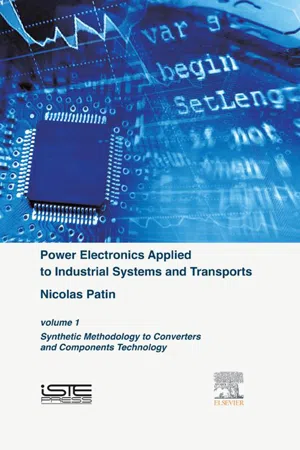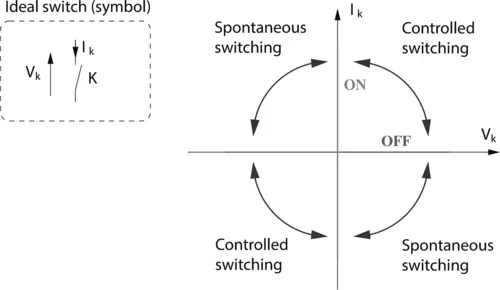
Power Electronics Applied to Industrial Systems and Transports, Volume 1
Synthetic Methodology to Converters and Components Technology
- 192 pages
- English
- ePUB (mobile friendly)
- Available on iOS & Android
Power Electronics Applied to Industrial Systems and Transports, Volume 1
Synthetic Methodology to Converters and Components Technology
About this book
Power electronics is based on the switching operating mode of semiconductor components. On this basis, the concepts of type (voltage or current) and reversibility of interconnected sources make it possible to apply a methodology for the synthesis of various types of converters.Here the author presents the major types of components available, always from a user's point of view, with the gate drive/fire control and other auxiliary circuits that are required for their proper functioning (snubbers, for example). The different passive components (capacitors, coils and transformers) are discussed, as well as printed circuit technology, especially in the aspect of their design.This book also focuses on the importance of packaging by reviewing the electrical representation of components' thermal models and the currently available electronics' cooling technologies. Modeling is discussed, as well as different technological aspects used in the engineering design of an electronic power converter, useful for obtaining satisfactory performance and reliability.- Presenting the essential notions in power electronics from both the theoretical and technological perspectives- Dedicated chapters with a focus on connection rules, reversibility and impact choices of switches for converter synthesis- Presented from a user's perspective to enable you to apply the theory of power electronics to practical applications
Frequently asked questions
- Essential is ideal for learners and professionals who enjoy exploring a wide range of subjects. Access the Essential Library with 800,000+ trusted titles and best-sellers across business, personal growth, and the humanities. Includes unlimited reading time and Standard Read Aloud voice.
- Complete: Perfect for advanced learners and researchers needing full, unrestricted access. Unlock 1.4M+ books across hundreds of subjects, including academic and specialized titles. The Complete Plan also includes advanced features like Premium Read Aloud and Research Assistant.
Please note we cannot support devices running on iOS 13 and Android 7 or earlier. Learn more about using the app.
Information
Theoretical Tools and Active Components for Power Electronics
Abstract
1.1 Electrical circuits and power electronics
1.1.1 General case
1.1.2 Extension to power electronics

| Current sources | Voltage sources |
| DC machine | Battery |
| Synchronous machine (generally three-phase) | Solar panel |
| Asynchronous machine (generally three-phase) | Fuel cell |
| Transformer winding | Piezoelectric transformer |
| Inductor dipole in series | Condenser dipole in parallel |
| Electrical network with finite power | Electrical network with infinite power |

Table of contents
- Cover image
- Title page
- Table of Contents
- Copyright page
- Preface
- Introduction
- 1. Theoretical Tools and Active Components for Power Electronics
- 2. Thermics, Packaging and Power Component Technologies
- 3. Auxiliary Converter Circuits
- 4. Passive Components – Technologies and Dimensioning
- 5. Designing Printed Power Circuits
- Appendix: Formulas for Electrical Engineering and Electromagnetism
- Bibliography
- Index